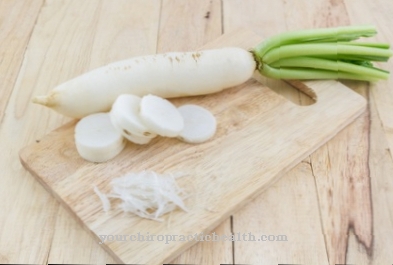The Sugar melon belongs to the pumpkin family. In botany, the fruit is called a berry and is mainly used as a fruit. The name results from the fairly high fructose content, which ensures that they taste very sweet. The water content of the sugar melon is slightly lower than that of the watermelon.
What you should know about sugar melon

The homeland of the sugar melon is believed to be in tropical and subtropical West Africa. It has been cultivated in Egypt for at least 4000 years. Nowadays, the sugar melon is grown worldwide in temperate climates, but also in dry and hot tropical regions.
About 500 different types of melons, which differ in terms of size, appearance and taste, come together under the umbrella term. However, the hollow inside and the pips in the middle of the fruit are always typical, whereas in the watermelon they are distributed over the entire pulp.
Depending on the variety, the melon is round to oblong. The skin of the fruit can be ribbed, smooth, reticulated or partially warty.
The color is either whitish, light green or green-yellow. When fully ripe it then turns yellow, orange-yellow or pink. The sweet pulp is mostly aromatic, white, yellowish, yellow-orange, orange to greenish. The sugar melon that is available in Germany usually weighs up to six kilograms. The sugar melon is available all year round.
Importance to health
The sugar melon not only tastes good, it is also extremely healthy because it contains important ingredients. It has a vitalising effect on the body, strengthens blood formation and improves protein utilization. Sugar melon is a delicious and healthy thirst quencher, especially in summer.
Thanks to the high proportion of provitamin A, it supports eyesight and cell growth. The beta-carotene protects against free radicals and harmful UV radiation. It has a positive effect on cell aging, skin and hair. The contained vitamin C strengthens the immune system, serves as a mood enhancer and improves concentration. The potassium content in sugar melon has a dehydrating effect. The melon has a cleansing effect on the kidneys. Excess uric acid and salt are flushed out of the body. Therefore, consumption is particularly recommended for gout and rheumatism.
The iron and the B vitamins are said to help against hair loss. With the high proportion of fructose, the sugar melon provides some calories and carbohydrates, but with almost 0 grams of fat and the dehydrating effect, it is still a good choice for figure-conscious people.
Ingredients & nutritional values
| Nutritional information | Amount per 100 grams of cantaloupe melon |
| Calories 34 | Fat content 0.2 g |
| cholesterol 0 mg | sodium 16 mg |
| potassium 267 mg | carbohydrates 8 g |
| Fiber 0.9 g | protein 0.8 g |
In terms of vitamin C content, the sugar melon is not one of the front runners, but it is in the good midfield. Other vitamins include E, K and B vitamins. In addition, it can score with a very good content of the important provitamin A. The valuable minerals contained in the sugar melon include potassium, calcium, sodium, magnesium, chlorine and phosphorus. The water content of more than 90 percent is also remarkable, which makes the sugar melon a delicious thirst-quencher.
Intolerances & allergies
A nice piece of melon, for many people it is a wonderful refreshment, especially in summer. But some people suffer from unpleasant consequences after consumption, for example from nausea, diarrhea or abdominal cramps. The reason for this is that the affected person's absorption of fructose from the intestine into the blood is disturbed. We are talking about fructose malabsorption.
Shopping & kitchen tips
When buying a sugar melon, quality should be considered. The smell in particular is a good sign with regard to the degree of ripeness. The fruit should have a pleasantly sweet scent. If a sugar melon is overripe, it smells slightly fermented.
In addition, the taste changes with overripe fruits, because the sugar melon tastes perfumed in this case. The skin of a ripe melon is evenly colored and also no longer too firm. With some varieties, a small open space forms on the pistil, which is also positive. The sugar melon prefers storage at room temperature for two to four hours, but it can be refrigerated a little before consumption if necessary. A ripe melon generally tolerates the cold better than a fruit that has just been picked. The melon shouldn't be kept in the refrigerator for too long as it quickly loses its aroma. Sometimes the cold also makes it uncomfortably bitter.
Bought in portions, it doesn't last very long. The interfaces should be covered with cling film. Ideally, the melon is consumed after three days at the latest. A ripe melon is best not stored next to fruit or vegetables that give off the ripening gas ethylene, for example apples, tomatoes, peas and aubergines. In terms of preparation, the melon is best cut in half crosswise, because the seeds can then be easily removed with a spoon.If you want to enjoy the sugar melon pure, you can either cut it into wedges or dice it.
Preparation tips
The sugar melon can be used in many ways and is easy to use. The pulp can be sliced and enjoyed as a refreshing snack, but it also goes great in a fruit salad, quark dish, in muesli or in a punch. It is optimally shaped with a ball cutter. It is also popular in smoothies, milkshakes and sorbets.
At a party, the pulp is often served with boiled ham. The melon thus offers a good and healthy change from the mostly heavy meat dishes and also ensures sufficient water supply. Digestion benefits from this. They are also a good choice in a jam, on a cake or a cake. But the melon also goes very well with a shrimp or chicken salad. When frozen, sugar melon balls are an ideal replacement for ice cubes in summer drinks. A cold melon soup is also perfect on hot summer days. It can be prepared Asian with coconut milk and ginger or Mediterranean with cucumber.
The melon generally goes very well with poultry, soft cheese, lettuce, mint, and white and green pepper. With the sugar melon, the following applies: Anything that tastes good is allowed, because it doesn't just go well with sweet dishes. It also gives spicy things a refreshing note. However, one thing should always be observed: The kernels of the sugar melon have no place in any dish. They should always be removed beforehand. There are now even various forms that do not contain kernels.
























.jpg)



